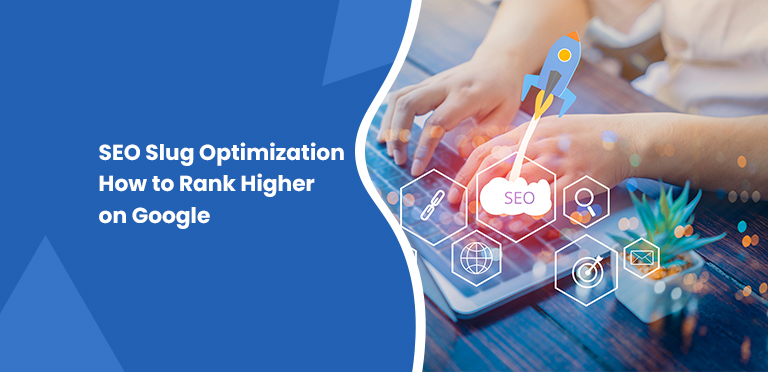SEO Slug Optimization: How to Rank Higher on Google



Have you ever wondered why some websites rank higher on Google while others struggle to get noticed? The secret might be hiding in plain sight – right in your URL. An SEO slug, the part of your URL that describes a specific page, plays a crucial role in how search engines understand and rank your content.
Think of an SEO slug as your page’s digital (web) address. The slug is the text that appears after the domain name in the URL. For example, in “www.website.com/seo-slug-optimization,” the phrase “seo-slug-optimization” is the slug.
SEO slugs are important because they enhance website visibility, improve search engine rankings, and provide a clear, user-friendly URL structure.
A well-optimized slug can:
- Make your URLs more user-friendly
- Help search engines better understand your content
- Boost your website’s visibility on search results
- Improve your click-through rates
Ready to transform your URLs into powerful Search Engine Optimization (SEO) tools? We’ll walk you through the essential best practices for creating SEO-friendly slugs and show you exactly how to optimize them for Google. Let’s optimize URLs for improved search rankings.
SEO URL Slugs- Meaning and Importance
What is meant by URL Slug?
The slug is the specific part of your URL that identifies a particular page on your website. Think of it as your page’s unique address – just like your home address helps people find you, a website slug helps users and search engines locate specific content on your site.
To better understand SEO slugs, let’s break down the components of a URL. A typical URL structure looks like this:
https://www.example.com/blog/seo-tips-2024
In this URL:
https:// is the protocol
www.example.com is the domain name
/blog/ is the directory path
seo-tips-2024 is the slug
Why Are SEO Slugs Important?
SEO slugs play a vital role in boosting your website’s performance and user engagement. The purpose of a slug is to create a clear, concise, and SEO-friendly URL that improves search engine rankings and user navigation. Let’s explore their key benefits:
1. Enhanced User Experience
Well-crafted SEO slugs make your URLs clear and descriptive, helping visitors understand what to expect before clicking. This clarity builds trust and reduces bounce rates as users find exactly what they’re looking for. Think of it like a street sign – the clearer it is, the more likely people will reach their destination.
2. Search Engine Rankings
Google’s algorithms favor URLs that accurately describe page content. When your slugs contain relevant keywords and maintain a clean structure, search engines can better understand and index your content. This improved understanding often results in higher rankings for relevant search queries.
3. Click-Through Rate Optimization
Your URL appears in search results, social media shares, and external links. A descriptive slug can significantly impact click-through rates:
- Users trust URLs that preview the content
- Clean slugs look more professional and credible
- Keyword-rich slugs stand out in search results
4. Site Authority Building
Professional, consistent slug structures contribute to your website’s perceived authority. When visitors see well-organized URLs across your site, they’re more likely to view your platform as a reliable information source. This perception can lead to:
- Increased time spent on your website
- Higher engagement rates
- More frequent return visits
- Natural backlink generation
These benefits combine to create a powerful impact on your site’s visibility and success in search rankings.
Best Practices for Creating SEO-Friendly Slugs
Here are some best practices that will help you create effective SEO slugs for your website:
1. Strategic Keyword Integration
Your target keyword should appear naturally in your slug (for SEO). Here’s how to do it right:
- Use your primary keyword near the beginning of the slug
- Keep it relevant to your page content
- Avoid keyword stuffing (one main keyword is enough)
Example: For a page about “best coffee makers,” use /best-coffee-makers instead of /coffee-brewing-machines-2023-reviews
2. Length and Format Guidelines
The perfect slug maintains a delicate balance between being descriptive and concise:
- Stick to 3-6 words
- Use lowercase letters exclusively
- Separate words with hyphens, not underscores
- Remove stop words (a, an, the, in, on)
Example: /how-to-brew-perfect-coffee is better than /How_To_Make_The_Perfect_Cup_Of_Coffee_At_Home
3. Maintaining Relevance and Consistency
Your slug should mirror your content’s purpose across all platforms:
- Match your page title’s main topic
- Keep URL structure consistent throughout your site
- Use the same format across different platforms (WordPress, Shopify, Wix)
Pro tip: Create a slug style guide for your website to maintain consistency. If your page title is “10 Amazing Coffee Brewing Tips for Beginners,” your slug could be /coffee-brewing-tips-beginners
Remember to check your slug’s readability – if a person can’t easily read it aloud, it needs simplification. Your slug should tell both users and search engines exactly what they’ll find on your page.
Avoiding Special Characters in Your Slug
Special characters in URLs can create technical issues that harm your website’s performance. When users share links containing special characters, these URLs might break or display incorrectly across different platforms and web browsers.
Let’s look at what you should avoid in your slugs:
Unacceptable Characters:
- Spaces ( )
- Question marks (?)
- Ampersands (&)
- Percentage signs (%)
- Hash symbols (#)
- Equal signs (=)
- Plus signs(+)
- Dollar signs ($)
- Exclamation marks (!)
- Apostrophes (‘)
- Quotation marks (” “)
Acceptable Characters:
- Hyphens (-)
- Letters (a-z)
- Numbers (0-9)
Here’s a practical example:
Bad slug: my_product@2023!special&offer
Good slug: my-product-2023-special-offer
Search engines might misinterpret special characters as coding elements or commands, leading to indexing problems. Some characters trigger specific browser behaviors – for instance, the question mark (?) typically indicates the start of URL parameters.
URL encoding can convert special characters into complex character sequences, making your URLs longer and harder to read. A simple apostrophe (‘) becomes ‘%27’ when encoded, creating unnecessary complexity in your URL structure.
Use hyphens as word separators, as they are the industry standard and preferred by Google. Hyphens create clear word boundaries that both users and search engines can easily understand.
How to Optimize Your Slug for Google
Let’s walk through the process of creating and optimizing your SEO slugs for better Google rankings.
1. Analyze Your Current URL Structure
- Open Google Search Console
- Navigate to the URL Inspection tool
- Enter your page URL to check its current status
- Review any potential issues flagged by Google
2. Edit Your Slug
- Remove the current slug from your URL
- Insert your primary keyword at the beginning
- Add supporting keywords naturally
- Keep it under 60 characters
Here’s a practical example:
Original URL: website.com/blog/post?id=123
Optimized URL: website.com/seo-slug-optimization-guide
Tools for Monitoring Slug Performance
Google Search Console offers valuable insights into your URL performance:
- Track click-through rates
- Monitor indexing status
- Analyze mobile usability
- Review search appearance
You can also use these specialized tools:
- Screaming Frog SEO Spider – Audits URL structures
- Ahrefs URL Rating checker – Measures URL authority
- Moz Pro – Tracks URL ranking changes
Remember to check your slugs’ performance weekly. A declining click-through rate might indicate the need for slug optimization. Watch your rankings for specific keywords related to your optimized slugs – this data helps refine your optimization strategy.
Common Mistakes to Avoid in SEO Slug Optimization
Creating SEO-friendly slugs might seem straightforward, but many website owners make critical mistakes that can harm their search rankings. Let’s explore these common pitfalls to help you maintain effective URL structures.
1. Overcomplicated Slugs
Creating lengthy, complex slugs with unnecessary words clutters your URLs and confuses both users and search engines. Keep your slugs simple and focused on essential keywords.
Example of a bad slug: /blog/2023/01/how-to-create-the-best-seo-friendly-url-structure-for-your-website-content-page
Better version: /blog/create-seo-friendly-urls
2. Mobile Optimization Oversights
Long URLs can break awkwardly on mobile devices, creating a poor user experience. With Google’s mobile-first indexing, your slugs need to display properly across all devices.
3. Common Technical Errors
Here are some common technical errors to avoid in your SEO slug optimization:
- Using underscores instead of hyphens
- Including dates that quickly become outdated
- Duplicating keywords unnecessarily
- Keeping default numeric slugs (like /post-123456)
4. URL Structure Changes Without Redirects
Changing existing slugs without implementing proper 301 redirects can lead to broken links and lost traffic. When updating URLs, always set up redirects to preserve your SEO value and user experience.
5. Auto-Generated Slugs
Relying on automatically generated slugs without review can result in missed optimization opportunities. Take time to customize your slugs based on targeted keywords and content relevance.
Remember to audit your existing slugs regularly and fix any issues you find. A consistent URL structure helps maintain your site’s authority and improves user navigation.
Conclusion
A slug URL means the part of a URL that identifies a specific web page in a readable, SEO-friendly format.
Optimizing URL slugs is essential for improving website visibility, user experience, and search rankings. Well-structured slugs guide both users and search engines, enhancing site authority and increasing ranking potential. By using keywords strategically, formatting correctly, and maintaining consistency, you can strengthen your online presence.
Mastering SEO slug optimization may seem challenging, but the benefits are significant. At SEO Expert New York, we specialize in URL optimization strategies aligned with Google’s best practices. Our expert team helps businesses enhance their online presence through advanced SEO solutions, including effective slug optimization techniques that deliver measurable results.
Frequently Asked Questions (FAQs)
URL slugs can be changed after publishing. Remember to set up 301 redirects from old URLs to new ones to maintain SEO value and prevent broken links.
Ensure slugs contain 3-6 words and remain within 50-60 characters. This length balances SEO effectiveness with user-friendliness.
It’s best to avoid dates in slugs unless your content is specifically time-sensitive, like news articles. Dateless slugs stay relevant longer.
While stop words (a, the, and) don’t significantly impact SEO, removing them creates cleaner, more focused URLs. Use your judgment based on readability.
Google recommends using hyphens (-) instead of underscores (_) to separate words in URLs. Hyphens are treated as word separators, while underscores are read as word joiners.